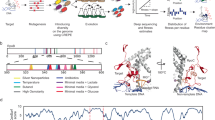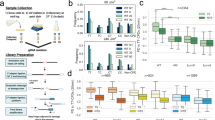Abstract
The relationship between the number of randomly accumulated mutations in a genome and fitness is a key parameter in evolutionary biology1,2,3,4,5. Mutations may interact such that their combined effect on fitness is additive (no epistasis), reinforced (synergistic epistasis) or mitigated (antagonistic epistasis). We measured the decrease in fitness caused by increasing mutation number in the bacterium Salmonella typhimurium using a regulated, error-prone DNA polymerase (polymerase IV, DinB). As mutations accumulated, fitness costs increased at a diminishing rate. This suggests that random mutations interact such that their combined effect on fitness is mitigated and that the genome is buffered against the fitness reduction caused by accumulated mutations. Levels of the heat shock chaperones DnaK and GroEL increased in lineages that had accumulated many mutations, and experimental overproduction of GroEL further increased the fitness of lineages containing deleterious mutations. These findings suggest that overexpression of chaperones contributes to antagonistic epistasis.
This is a preview of subscription content, access via your institution
Access options
Subscribe to this journal
Receive 12 print issues and online access
$209.00 per year
only $17.42 per issue
Buy this article
- Purchase on Springer Link
- Instant access to full article PDF
Prices may be subject to local taxes which are calculated during checkout



Similar content being viewed by others
References
Wolf, J.B., Brodie, E.D. & Wade, M.J. Epistasis and the Evolutionary Process (Oxford University Press, New York, 2000).
Whitlock, M.C., Philips, P.C., Moore, F.B. & Tonsor, S.J. Multiple fitness peaks and epistasis. Annu. Rev. Ecol. Syst. 26, 601–629 (1995).
Kimura, M. & Maruyama, T. The mutational load with epistatic gene interactions in fitness. Genetics 54, 1337–1351 (1966).
Lande, R. Risk of population extinction from fixation of new deleterious mutations. Evolution Int. J. Org. Evolution 48, 1460–1469 (1994).
Kondrashov, A.S. Deleterious mutations and the evolution of sexual reproduction. Nature 336, 435–440 (1988).
Mukai, T. The genetic structure of natural populations of Drosophila melanogaster. VII. Synergistic interaction of spontaneous mutant polygenes controlling viability. Genetics 61, 749–761 (1969).
de Visser, J.A., Hoekstra, R.F. & van den Ende, H. Test of interaction between genetic markers that affect fitness in Aspergillus niger. Evolution Int. J. Org. Evolution 51, 1499–1505 (1997).
de Visser, J.A., Hoekstra, R.F. & van den Ende, H. An experimental test for synergistic epistasis and its application in Chlamydomonas. Genetics 145, 815–819 (1997).
Elena, S.F. & Lenski, R.E. Test of synergistic interactions among deleterious mutations in bacteria. Nature 390, 395–398 (1997).
Peters, A.D. & Keightley, P.D. A test for epistasis among induced mutations in Caenorhabditis elegans. Genetics 156, 1635–1647 (2000).
Whitlock, M.C. & Bourguet, D. Factors affecting the genetic load in Drosophila: synergistic epistasis and correlations among fitness components. Evolution Int. J. Org. Evolution 54, 1654–1660 (2000).
Szafraniec, K., Wloch, D.M., Sliwa, P., Borts, R.H. & Korona, R. Small fitness effects and weak genetic interactions between deleterious mutations in heterozygous loci of the yeast Saccharomyces cerevisiae. Genet. Res. 82, 19–31 (2003).
Kim, S.R. et al. Multiple pathways for SOS-induced mutagenesis in Escherichia coli: an overexpression of dinB/dinP results in strongly enhancing mutagenesis in the absence of any exogenous treatment to damage DNA. Proc. Natl. Acad. Sci. USA 94, 13792–13797 (1997).
Lenski, R.E., Ofria, C., Collier, T. & Adami, C. Genome complexity, robustness and genetic interactions in digital organisms. Nature 400, 661–664 (1999).
Carroll, R. & Ruppert, D. Transformation and Weighting in Regression (Chapman and Hall, London, 1988).
Davidian, M. & Giltinan, D. Nonlinear Models for Repeated Measurement Data (Chapman and Hall, London, 1995).
Wilke, C.O. & Adami, C. Interaction between directional epistasis and average mutational effects. Proc. R. Soc. Lond. B 268, 1469–1474 (2001).
Bonhoeffer, S., Chappey, C., Parkin, N.T., Whitcomb, J.M. & Petropoulos, C.J. Evidence for positive epistasis in HIV-1. Science 306, 1547–1550 (2004).
Burch, C.L. & Chao, L. Epistasis and its relationship to canalization in the RNA virus phi 6. Genetics 167, 559–567 (2004).
Sanjuan, R., Moya, A. & Elena, S.F. The contribution of epistasis to the architecture of fitness in an RNA virus. Proc. Natl. Acad. Sci. USA 101, 15376–15379 (2004).
Poon, A. & Otto, S.P. Compensating for our load of mutations: freezing the meltdown of small populations. Evolution Int. J. Org. Evolution 54, 1467–1479 (2000).
Kibota, T.T. & Lynch, M. Estimate of the genomic mutation rate deleterious to overall fitness in E. coli. Nature 381, 694–696 (1996).
Rutherford, S.L. & Lindquist, S. Hsp90 as a capacitor for morphological evolution. Nature 396, 336–342 (1998).
Fares, M.A., Ruiz-Gonzalez, M.X., Moya, A., Elena, S.F. & Barrio, E. Endosymbiotic bacteria: groEL buffers against deleterious mutations. Nature 417, 398 (2002).
Queitsch, C., Sangster, T.A. & Lindquist, S. Hsp90 as a capacitor of phenotypic variation. Nature 417, 618–624 (2002).
Tomoyasu, T., Mogk, A., Langen, H., Goloubinoff, P. & Bukau, B. Genetic dissection of the roles of chaperones and proteases in protein folding and degradation in the Escherichia coli cytosol. Mol. Microbiol. 40, 397–413 (2001).
Muller, H.J. The relation of recombination to mutational advance. Mutat. Res. 16, 2–9 (1964).
Wagner, G.P. & Gabriel, W. Quantitative variation in finite parthenogenetic populations: what stops Muller's ratchet in the absence of recombination? Evolution Int. J. Org. Evolution 44, 715–731 (1990).
Torkelson, J. et al. Genome-wide hypermutation in a subpopulation of stationary-phase cells underlies recombination-dependent adaptive mutation. EMBO J. 16, 3303–3311 (1997).
Roth, J.R. et al. Regulating general mutation rates: examination of the hypermutable state model for Cairnsian adaptive mutation. Genetics 163, 1483–1496 (2003).
Acknowledgements
We thank P. Geli for help with statistics and B. Albiger, C. Kyriakopoulou, K. Maisnier-Patin and A. Poplawski for sharing their expertise in protein purification and immunological methods. This work was supported by grants from the Swedish Research Council and Uppsala University to D.I.A.
Author information
Authors and Affiliations
Corresponding author
Ethics declarations
Competing interests
The authors declare no competing financial interests.
Supplementary information
Supplementary Fig. 1
Chromosomal distribution and size of the random DNA fragments sequenced. (PDF 157 kb)
Supplementary Fig. 2
Negative logarithmic of fitness as a function of the logarithmic number of mutations, selective reduction factor. (PDF 80 kb)
Supplementary Table 1
Location and type of mutations identified in the evolved lineages. (PDF 48 kb)
Supplementary Table 2
Lineages with altered mutation rates. (PDF 42 kb)
Supplementary Table 3
Fitness and number of mutations. (PDF 45 kb)
Supplementary Table 4
List of bacterial strains and plasmids. (PDF 53 kb)
Supplementary Note
Calculation of the number of mutations and impact of potential biases on the observed results. (PDF 177 kb)
Rights and permissions
About this article
Cite this article
Maisnier-Patin, S., Roth, J., Fredriksson, Å. et al. Genomic buffering mitigates the effects of deleterious mutations in bacteria. Nat Genet 37, 1376–1379 (2005). https://doi.org/10.1038/ng1676
Received:
Accepted:
Published:
Issue Date:
DOI: https://doi.org/10.1038/ng1676
This article is cited by
-
Idiosyncratic epistasis creates universals in mutational effects and evolutionary trajectories
Nature Ecology & Evolution (2020)
-
The use of SWATH to analyse the dynamic changes of bacterial proteome of carbapanemase-producing Escherichia coli under antibiotic pressure
Scientific Reports (2018)
-
Isolating Escherichia coli strains for recombinant protein production
Cellular and Molecular Life Sciences (2017)
-
Role of auxiliary proteins in Rubisco biogenesis and function
Nature Plants (2015)
-
The cost of antibiotic resistance depends on evolutionary history in Escherichia coli
BMC Evolutionary Biology (2013)



